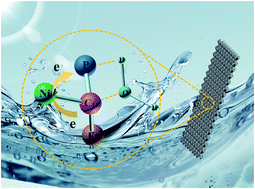Pulse electrodeposited CoFeNiP as a highly active and stable electrocatalyst for alkaline water electrolysis†
Abstract
Developing high-performance and cost-effective electrocatalysts for water electrolysis would be very beneficial for efficient conversion and storage of sustainable hydrogen energy. As potential electrocatalysts, the improvement of water splitting catalyzed by transition metal phosphides remains a great challenge. Modulating the electronic state through atomic interactions is highly effective in stimulating the intrinsic activity. Here, a simple and controllable pulse-electrodeposition method is used to prepare iron and nickel co-doped cobalt phosphide (CoP) as a bifunctional electrocatalyst for water splitting in alkaline medium. Doping with iron and nickel significantly modulates the electronic state of CoP, thus resulting in enhanced activity for the hydrogen evolution reaction with a low overpotential of 33 mV at 10 mA cm−2 current density. Furthermore, the in situ generated (Ni,Fe)xCo1−x oxyhydroxides/hydroxides on the surface of CoFeNiP/NF during the oxygen evolution reaction facilitate high OER activity with a low overpotential of 280 mV at 10 mA cm−2 current density. Notably, doping with iron and nickel effectively suppresses the cobalt deterioration during the anodic oxidation process, which ensures a negligible deactivation after twenty-hour bulk electrolysis continuously operating at a constant current density.



 Please wait while we load your content...
Please wait while we load your content...